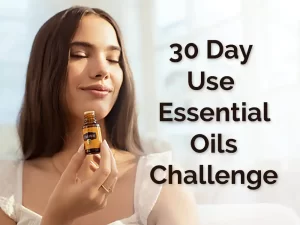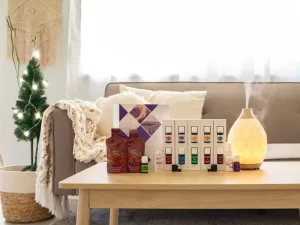Why Blend Essential Oils?
There are many good reasons!
Single essential oils have unique characteristics that have the ability to affect us on many levels – emotionally, spiritually and physically. Experience has shown me that only those essential oils that are right for a particular person, at that point in time will have the power to impact them on any level.
This is why when you look up a reference book for a particular essential oil they will often have a number of different essential oils and blends listed. But, what may work for one person doesn’t work for another. Likewise, sometimes what worked for someone once may not work in the same way, weeks or months later.
Most importantly, some people may experience an immediate effect from using essential oils and others may find the results take time as the essential oil or blend is working to restore balance to the body.
The effectiveness of essential oils may be enhanced when blended with other essential oils in a particular way. Each essential oil contains different molecules, both large and small. A good blend will contain a mix of different size molecules. A particular blend may be more effective than another blend or a single essential oil, because of this mix in size, weight, shape and type. As a result, each molecule within an essential oil has its own role in bringing about harmony. [i]
Spiritual Experience when you blend essential oils
When you blend essential oils it is quite a spiritual experience that allows you to tap into not only your knowledge base, but also your creativity and intuition. Women not only benefit from having ‘women’s intuition’ but also have… better noses. Sssh! Don’t tell the guys.
Blending is not like baking a cake, in that if you don’t get the recipe exactly right it won’t work. However, if anyone has seen the movie “Chocolate for Love….” you will know that cooking has a lot to do with intention. Someone may give you a recipe and when you make it, it never turns out the same as the other person’s, even though you followed the recipe exactly.
According to John Steele in the International Journal of Aromatherapy (Vol II, No.2) “Creative blending is an aesthetic alchemical process… A blend is not made at once, rather it evolves, it organically grows and interacts not only with the essential oils, but also with the blender.”
Rules of Blending Essential Oils
Are there Rules to follow when you blend essential oils?
The simple answer is ‘No’. However, when starting out there are a few guidelines listed below which may be useful to follow.
- A Synergy is a blend purely made up of mutually enhancing essential oils.
- Blending is where essential oils are added to a carrier such as jojoba oil, macadamia oil or almond oil.
- Start by blending no more than 3 or 4 essential oils at a time.
- The more intense the odour of an essential oil the smaller amount needed or it will overpower the blend.
Carefully consider the Who and the Why
- Choosing which essential oils to include in a blend will be based on the reason you are creating the blend. Is there a therapeutic purpose to the blend or are you blending a perfume?
- The blend needs to be holistic and reflect the energetic balance and therapeutic needs of the person the blend is for. This takes into consideration the emotional/mental/spiritual state of the person as well as the presenting physical symptoms.
- Where is the blend going to be used and by whom? If the blend is going to be used on the skin, there are certain essential oils which irritate the skin and this needs to be considered when including these essential oils in a blend. Particularly if the blend is for a particularly sensitive part of the body. If the blend is for a child or an elderly person then this too needs to be considered when preparing the blend.
- It is advisable not to blend essential oils with opposite effects when starting out. For example an essential oil that has calming properties as well as stimulating. However, when the constituents of both essential oils mix they can have a totally different effect to the single oils alone.
- The blend should be pleasant to the person using it. This can mean the difference between them using it or not, as well as the effect it has on their healing and wellbeing.
Which essential oils do I use and recommend? Good question, because not all essential oils are the same. Find out which essential oils I choose to blend here.
Dilution
This is a contentious issue among aromatherapists. The British model of aromatherapy discourages the use of essential oils neat on the body, justifying this with outdated views about their safety. So should we dilute essential oils or are they more effective if applied neat?
When trying to explain whether to dilute essential oils or not, I use the analogy of being invited to a party. At this party there are lots of small molecules similar to them. If, when they arrive at the party there were other people in exactly the same dress as them, what would they do? Well if it was me, straightaway I would shrink into a corner somewhere and hide. But if they arrived at the party and they were the only one there in this fabulous dress, then they could relax, exuding confidence and power, dancing all night long.
Blending for Beginners
When therapeutic grade essential oils are used neat the molecules are in higher concentrations and the old adage ‘more is best’ isn’t always the case. Certainly, there are applications where I would always use a neat application – this is dependent on the essential oil I choose and the purpose I’m using it for. However, there is definitely a need to dilute essential oils which are hot or cause skin irritation. Plus, diluting essential oils makes the essential oils go further, is more cost effective and at times is the best method of delivery.
Dilution is generally also necessary with young children, the elderly and those whose health is seriously compromised. When essential oils are diluted they can be applied more easily, particularly over a larger area. When diluted, the smaller molecules are more active and dilution can mean you use less, so it saves money.
Below is a table that demonstrates the suggested dilution ratios.
Dilution Ratios
| Dilution | Volume of Carrier Oil | Drops of Essential Oil |
| 3% | 5mls | 3 drops |
| 5% | 5mls | 5 drops |
| 2.5% | 15mls | 7-8 drops |
| 5% | 15mls | 15 drops |
| 2.5% | 30mls | 15 drops |
| 5% | 30mls | 30 drops |
Diluting Essential Oils for Children and the Elderly
| Age | Amount | Dilution | Volume of Carrier Oil | Drops of Essential Oil |
| 0-4 years | 1/10 of adult dose | 5% | 10 drops | 1 drop |
| 5-8 years | 1/6 to 1/3 of adult dose | 5% | 10 drops | 2-4 drops |
| 8-12 years | 1/3 to ½ adult dose | 5% | 10 drops | 4-5 drops |
| 12-15 years | ½ to 2/3 adult dose | 5% | 10 drops | 5-8 drops |
| Elderly person in frail condition | ½ adult dose | 5% | 10 drops | 5 drops |
What is Aesthetic Blending?
This type of blending is used in the perfume industry and aims to create a pleasing fragrance. The blender chooses essential oils that smell nice together, based on how well they harmonise and complement each other. This type of blending was categorised in the 19th Century by a Frenchman named S. Piesse who likened the evaporation rate of an essential oil to the concept of scales in music, with top, middle and base notes. Accordingly, he believed that a balanced blend would have top, middle and base notes.
As mentioned previously, the lighter, smaller molecules in essential oils are more aromatic, but their fragrance is short lived. Teaming these with the larger, heavier molecules that are less aromatic but have a longer biological half-life, extends the fragrance and their therapeutic action lasts longer.
The molecules which make up the top, middle and base notes evaporate at different rates, so we can smell the different parts over time. I notice this when I apply a blend in the morning. At first, I can smell the citrusy, floral scents, but by the end of the day I am left with the woody, earthy ones of the base notes.
Which essential oils are which note?
Not everyone agrees on which essential oils fall into which category and you will come across books which put the same essential oils into different categories. This reflects the individuality inherent in essential oils and in practitioners. Some essential oils may act as a top note when blended with other essential oils, but in other blends they act as the middle note. While some may even extend across top, middle and base notes. Examples of this are Ylang Ylang, Jasmine, Rose and Neroli.
Top Note Essential Oils – Soprano
These are the essential oils made up of smaller, lighter molecules which evaporate into the air quickly, usually within 24 hours. They are the first note which you smell in a blend and don’t last long. Top notes have a sharp, fresh, light quality. The more volatile top notes are often more intense and therefore a smaller amount is required in a blend [ii]. They are obtained from flowers, leaves and fruits. Examples of top note essential oils include:
| Basil | Bergamot | Cardamom | Cinnamon Bark |
| Clove | Coriander | Eucalyptus Radiata | Grapefruit |
| Hyssop | Jasmine | Lemon | Lime |
| Orange | Peppermint | Rose | Spearmint |
Top Notes penetrate the body quickly and are fast acting. For this reason they are used to support acute conditions, shock or muscle tension. Top notes are stimulating and uplifting to the mind and body. Energetically they are used for opening and releasing. These are aldehydes and esters.[iii]
Middle Note Essential Oils – Alto and Tenor
Middle Notes are the essential oils made up of medium size molecules which evaporate at a moderate pace, usually within 2-3 days. Generally, these essential oils are obtained from flowers, herbs and leaves. Examples of Middle note essential oils include:
| Black Pepper | Cardamom | Clary Sage | Clove |
| Cypress | Fennel | Geranium | Juniper |
| Lavender | Lemongrass | Marjoram | Melissa |
| Myrtle | Rose | Rosemary | Ylang Ylang |
Middle Notes are the key to any blend, making up the majority (50-60%) of it. They enhance, equalise and balance. Typically they are warm, soft and mellow. Usually they are made up of monoterpene alcohols. They mostly regulate the bodily functions such as digestion.
Base Note Essential Oils – Bass
These are the largest, heaviest molecules and the slowest to evaporate into the air. They can last up to one week. Some base notes may not be detected when the bottle is first opened and can take up to a few minutes to smell, for example Sandalwood. When smelt from the bottle it can be quite faint but when applied to the skin it reacts strongly and the scent can linger for hours.
Compared to Top notes, the scent of Base notes tends to develop over time, leaving a lasting impression of their fragrance. Some base notes are intense and can overpower a blend. Base notes have a deepness and roundness to them.[iv]
Base notes fix the fragrance of the other oils in the blend, causing them to evaporate slower, making the blend last longer. They have a rich, heavy and pleasant scent. They are mostly obtained from woods and resins. Examples of base note essential oils include:
| Angelica | Black Spruce | Cassia | Cedarwood |
| Cinnamon Bark | Clove | Frankincense | Ginger |
| Jasmine | Myrrh | Patchouli | Rose |
| Sandalwood | Vanilla | Vetiver | Ylang Ylang |
Base notes sedate and relax the mind and body. In energetic terms, base notes are grounding, relaxing and stabilising. They are mostly high in sesquiterpenes and usually make up 5-15% of the blend.
Intuitive Blending – the nose knows
Intuitive Blending is a psychological and spiritual approach to blending. It requires the blender to be discerning and rely on perception and intuition. This level of blending requires a melding of the earlier levels of blending. An in-depth knowledge of the chemistry and botany of essential oils is needed as well as the anatomy and physiology of the body. Using this knowledge and our noses own sensory discernment it focuses on resolving disharmony and restoring emotional and spiritual balance. It is, if you like, our ability to ‘sense’ what is required. [v]
Aromatherapists who use this type of blending to blend essential oils may also use tools such as pendulums or muscle testing to ascertain the right essential oil and the percentage of drops required in the blend they are creating.
Blending using the chemistry of essential oils
There is a third type of blending to blend essential oils which uses the chemical constituents of an essential oil to work out the correct percentage. I’m going to call this method PMS as it uses the ratio of phenols, monoterpenes and sesquiterpenes to create a synergy. I’ll write a separate post on this type of blending as it is an art in its own right.
If you have enjoyed this article please feel free to share it on social media so more people can learn how to blend essential oils. I am always keen to see the blends people create so please feel free to share them with me or tag me in them so I can check them out on social media. Thanks!
[i]David Stewart; The Chemistry of Essential Oils Made Easy – God’s Love Manifest in Molecules. 2005 CARE Publications
[ii]Linda Smith; Essential Oils for Physical Health and Well-Being Student Notebook 2011 (p118)
[iii]Linda Smith; Essential Oils for Physical Health and Well-Being Student Notebook 2011 (p115 and 116)
[iv]Linda Smith; Essential Oils for Physical Health and Well-Being Student Notebook 2011 (p117)
[v]Gabriel Mojay; Aromatherapy for Healing the Spirit – Restoring Emotional and Mental Balance with Essential Oils. 1997, London (p133)











 Subscribe to Hot Oily Mumma
Subscribe to Hot Oily Mumma